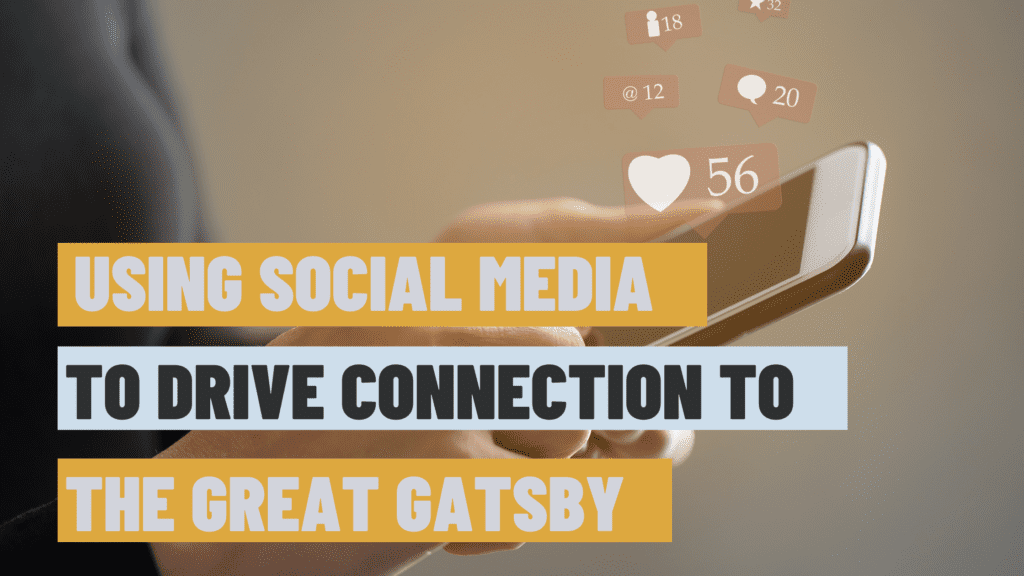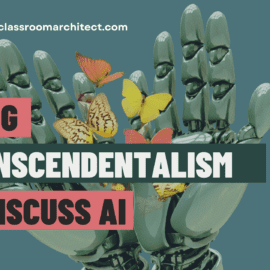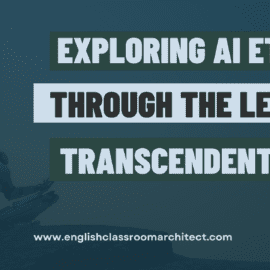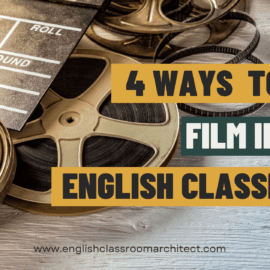Social media may be a surprising inspiration for ideas for teaching The Great Gatsby, but the parallels are strong. The Great Gatsby captures the essence of the era while exploring timeless themes that still resonate today. In our modern world, social media has become an integral part of students’ lives. What if we could bridge the gap between the classic novel and students’ contemporary experiences?
Social media plays a major role in the lives of many teenagers. Even for those that are not active on social media, they are all aware of the dangers and pitfalls, as well as the opportunities of social platforms. Using the awareness our students have to social media can be used as a bridge to teaching The Great Gatsby. Leveraging students’ familiarity with social media platforms can lead to a deeper examination of themes, a clearer understanding of the social structures of the novel, an awareness of the construction and illusion of identity, and a translation of the parallels of instant gratification between then and now. By tapping into their familiarity with these platforms, educators can unlock a treasure trove of creative ideas for teaching The Great Gatsby.

Table of Contents
Connecting Modern Realities with Classic Literature
Social media platforms have revolutionized the way we communicate, form identities, and navigate relationships. The Great Gatsby, with its exploration of illusion, wealth, materialism, and social dynamics, offers a lens through which we can examine these modern phenomena. As educators, we have the opportunity to tap into students’ understanding of social media and leverage it to enrich their exploration of the novel. We can guide our students to make connections between the characters’ false personas and the carefully curated profiles they encounter online, sparking deep discussions and critical thinking.
To make The Great Gatsby resonate with students, it’s crucial to establish a connection between the novel and their contemporary experiences. Social media provides an excellent entry point, as it mirrors the social dynamics depicted in the book. By drawing parallels between the personas individuals craft on social media and the characters’ false identities in the novel, students can gain a deeper understanding of the themes and motivations driving the story.
Social Media As a Social Experiment
One of my guilty pleasures is reality television. Here’s the scene: I’m sitting in my living room, binge watching The Circle, a popular show on Netflix. The Circle is a social reality game where contestants live alone in apartments and communicate to one another solely through a closed social marketing platform dubbed The Circle. Each week players vote someone out. The criteria for elimination is completely up to each individual player. The twist is that players can play as themselves or they can do a fake persona. What is interesting to me about this game is that some people will hunt for the catfish, but others decide that they don’t care about the persona and what is more important is the type of person that they are projecting (which could be “real” even if they are catfish).
At some point, it occurred to me how similar this scenario is to Jay Gatsby, who I have come to describe as the ultimate catfish before catfishing became a thing and it sparked a slew of ideas for teaching The Great Gatsby. If we eliminate the illegal ways Gatsby made his money (which is a significant problem, but put that aside for a moment), is the projection of a new version of himself something that we should shun? Or is he actually the exaggerated version of a self-made man? That bootstrap mentality is at the heart of the romanticized version of The American Dream, is it not? Or, bringing his illegal dealings back in, is that need to separate his climb from his achieved status what makes Gatsby’s fakeness so negative?
We as readers see this social dynamic in The Great Gatsby, with Nick Carraway. As Nick receives more information about characters he changes his judgements about them. For Gatsby, while he internally judges and admonishes, outwardly he remains a steadfast friend. At least from what Nick tells the reader, he reacts in the opposite way to her. He receives little additional information about her, but becomes increasingly judgmental and distances from her. Evaluating the reasons why he has these different approaches can lead to interesting conversations among your students.
Analyzing the Phenomenon of Persona Construction
Starting with social media and the fabrication of identity acts as a launching pad for discussing the illusion of identity in The Great Gatsby. On social media, people often present idealized versions of themselves, masking their true identities. This intriguing phenomenon aligns with the themes of illusion and identity portrayed in The Great Gatsby. As students delve into the novel, we can invite them to explore the concept of online personas and the motivations behind these constructed identities. Encouraging reflection on the consequences of maintaining false facades and examining how these facades affect their relationships with others can foster meaningful conversations. By intertwining these discussions with relevant passages from the novel, students can gain a deeper appreciation for the characters’ struggles and the timeless exploration of identity in The Great Gatsby.
We’ve seen multiple people demonstrate the opportunity of going from nothing to something, and we have seen people completely build their persona. An example is Kim Kardashian who is known for being famous for being famous. She has completely built her empire to the point where people often forget about how she first came into the public spotlight. What is the difference between Kim Kardashian and Jay Gatsby? Where do we draw the line between what we would call projecting an idealized version of ourselves and an identity that is considered a false persona?
How can you build on this in your classroom? Ideas for Teaching the Great Gatsby
- An assignment I did earlier in my career is casting celebrities to portray each of the characters. A new twist is to look at celebrity social media and use their posts, along with the text of The Great Gatsby, to justify the castings. This encourages students to think about the image the character is portraying and separating it from the comments Nick makes about them.
- Going back to The Circle, this year I tried an immersive experience similar to the reality show. Students impersonated characters and tried to build alliances with the direction that they could play up whatever qualities they wanted, but they had to play their character with fidelity to The Great Gatsby. Each session they voted out a character. It was interesting to see them really flesh out character motivations and make connections.
- I really like assignments where students track an idea or concept throughout the text. Students can consider how genuine a character is being at various points in the novel. These would make great graphs!
These ideas for teaching The Great Gatsby are designed to spark meaningful discussions and critical thinking.
Ideas for Teaching the Great Gatsby by Uncovering Themes Related to Wealth and Materialism
Wealth and materialism are central to The Great Gatsby, and social media provides an excellent backdrop for exploring these concepts. By exploring the relationship between social media and materialism, we can provide students with a fresh lens through which to examine the impact of material possessions, the pitfalls of consumer culture, and the role of wealth in shaping individuals’ lives and aspirations. By weaving in real-life examples from social media platforms, we can help students connect the dots between the novel and their own experiences.
To use another example, we saw the relationship of Jay-Z and Beyonce unfold, fumble, and strengthen through the media and their music. Throughout their time as music powerhouses the two have projected images of strength and power, amidst their moments of vulnerability.
I like to use them as an example for The Great Gatsby because to me they are arguably an embodiment of Jay Gatsby. They have both invented and reinvented themselves in order to climb the social ladder and they are now a power couple of hip hop. They are considered “new money” and have embraced the labels of their roots and demanded seats at the metaphorical table. Beyonce especially has leaned into her country background, but has also positioned herself with the establishment. We see this posting visually with a recent music video where the two videotaped inside the Louvre, associating themselves with respected art even beyond the music industry.
Both Jay-Z and Jay Gatsby are ambitious and driven individuals who rose from modest backgrounds to become incredibly successful. They amassed considerable wealth and used it to create a lavish lifestyle filled with extravagant parties and possessions. Gatsby throws extravagant parties to display his wealth and attract the attention of his lost love, Daisy Buchanan, while Jay-Z’s success in the music industry allowed him to enjoy a luxurious lifestyle.
The two have used their music videos and social media to reinforce images of wealth and power.
The Rise of Social Influencers
Marketing experts predict that we are moving away from this model, but teenagers are very familiar with social influencers that gain a following and then make money through affiliate marketing and endorsements, sometimes for products that do not fit their following and they have not even used. This has led to another way that social media nurtures false personas. Here is another opportunity to test Jay Gatsby against contemporary social media. In Gatsby’s mind, he has created everything that Daisy wants—meaning he can give her all the shirts and flowers money can buy. But, there is something missing. It is something genuine that is long gone. Similarly, influencers do make money, but for some that take any deal that they are given, it is at the expense of their credibility.
This sparks ideas for teaching The Great Gatsby incorporating their understanding of social media and social influencers:
- Discuss Jay Gatsby as a brand. Students may be familiar with personal branding as a business strategy. Give examples and ask them how successful they believe Gatsby is at creating his brand.
- Take this a step forward and ask students to create marketing materials for Jay Gatsby. These could be traditional like magazine ads, or they could include social media channels. Students can discuss the choices made in the campaign and the potential impact on Gatsby’s image and relationships
- Ask students to identify the places characters have influence over one another. You can design activities where they argue for the most powerful character.
- Host a Socratic Seminar discussing these issues. Here are some questions to get you started:
- How does Jay Gatsby’s pursuit of wealth and social status parallel the concept of personal branding in today’s era of social media influencers? Discuss the strategies he employs and the impact on his personal brand.
- In what ways does Jay Gatsby’s obsession with creating a persona and attracting Daisy Buchanan resemble the methods used by social media influencers to cultivate a following and monetize their online presence? Explore the similarities and differences between their approaches.
- Analyze the consequences of Jay Gatsby’s relentless pursuit of wealth and status. How does his desire for material possessions and the illusion of success affect his relationships and personal fulfillment? Can you draw any parallels to the potential pitfalls of social media influencers focusing solely on monetary gains?
- Discuss the notion of authenticity in both Jay Gatsby’s character and the world of social media influencers. How do false personas and the pressure to maintain a certain image impact individuals’ credibility and genuine connections with others?
Through these assignments, students can critically analyze the themes and characters of The Great Gatsby in the context of social media and personal branding, fostering a deeper understanding of the text and its relationship to contemporary issues.
Examining Relationships and Social Circles
Social media heavily influences how relationships are formed, maintained, and perceived. The Great Gatsby offers a rich exploration of complex relationships and social circles, reminiscent of the cliques and online communities that thrive in the digital realm. As we guide our students through the novel, we can encourage them to reflect on the impact of social media on their own relationships and social dynamics. How do virtual connections differ from face-to-face interactions? What are the advantages and drawbacks of these online relationships? By intertwining these questions with character analysis and discussions on the characters’ relationships in the novel, we can foster deeper understanding and critical thinking about the complexities of human connection in both the digital age and the 1920s.
In a world where Snoop Dogg calls Martha Stewart a friend, the rigidity of social circles may feel fabricated to teenagers. But, through social media they also have a fishbowl view of the fragility of some social networks. Comparing the social dynamics depicted in The Great Gatsby, such as the concept of the “East Egg” and “West Egg,” to social media’s influence on cliques and online communities becomes real for students when we talk about viral posts, social influencers, and cancel culture.
For students that have created relationships entirely online with no intention of ever meeting in real life, they can understand Jay Gatsby’s situation. People show up to his parties, but don’t show up for him. As a result, he would rather think people believe the rumors about him than uncover the truth of his beginnings. If Jay Gatsby was real and alive today would he have been treated the same?
Assignment Ideas:
- Online Relationship Reflection: Have students reflect on their own experiences with online relationships. Ask them to write a reflective essay discussing the similarities and differences between virtual connections and face-to-face interactions. Encourage them to draw parallels between their experiences and the relationships depicted in the novel. What advantages and drawbacks do they see in these online relationships?
- Social Circle Comparison: Ask students to research and analyze contemporary social circles or cliques formed through social media. They can compare these online communities to the social dynamics in The Great Gatsby. Students can create a presentation or a written analysis discussing the similarities, differences, and the impact of social media on the formation and maintenance of these circles.
Incorporating students’ familiarity with social media, these ideas for teaching The Great Gatsby bridge the gap between classic literature and contemporary experiences.
Conclusion
By leveraging students’ understanding of social media, educators can unlock a wealth of ideas for teaching The Great Gatsby. These innovative approaches connect the themes and social dynamics of the novel to students’ contemporary experiences, fostering deeper engagement and critical thinking. Incorporating activities that explore the illusion of identity, uncover themes of wealth and materialism, examine relationships and social circles, and confront the allure of instant gratification, teachers can create a dynamic learning environment that resonates with students and enhances their understanding of this timeless literary work.
Product in My Store You May Be Interested In
- The Great Gatsby Chapter 1 Character Analysis and Social Media Jigsaw Activity – capitalize on your students interest and knowledge of social media and get them engaging and moving as they connect to the identity construction of character in The Great Gatsby



